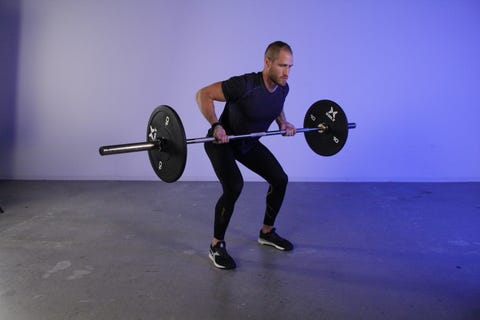There are tons of exercises you can use to build up your back muscles—trust us, we know just about all of them—but few are as effective (or as satisfying) as the classic barbell row. This particular variation of the row allows you to load up a large amount of weight onto the bar, get a good grip, and let it rip to pull it up to your chest. The move is a classic bodybuilding staple for a reason: it simply works, enabling you to build muscle and strength.
That said, you can’t expect to get the most out of this fundamental exercise if you don’t come correct to the bar. There are some specific cues lifters need to follow to get the move right to make the most of their effort—and since it’s one of those fundamental exercises that appear to be simpler than they actually are if you want to do them properly, there’s a solid chance your instruction might not have been up to par. If that’s the case, your training might be lacking, or worse, you could be opening yourself up to a chance of injury, particularly to your lower back.
Let the Men’s Health fitness team break down the barbell row for you, with step-by-step instruction and some helpful tips for the right way to stand, pull, and more. Fitness director Ebenezer Samuel, C.S.C.S. and fitness editor Brett Williams, NASM-CPT have put in the work to teach the move in the most effective way. Add it to your back day, and you’ll soon be on the way to building more muscle and strength.
Barbell Row Benefits
The barbell row is an excellent exercise for building up your back muscles. More specifically, you’ll work your mid- and upper-back muscles, like the lats, rhomboids, traps, and rear delts. Your rotator cuffs and other shoulder stabilizers are also involved, making it a solid movement for “bulletproofing” your shoulders, according to Samuel. Thanks to the bent-over position, however, you’ll also have to get your glutes and core engaged more than you might expect. Finally, if you use the underhand grip Samuel suggests, you’ll challenge your biceps, brachialis, and forearms too, making the barbell row a low-key asset on arm day as well.
If you’re thinking about real world-benefits, the barbell row is an excellent way to train the fundamental rowing movement with a heavy load, which will pay off in real-life situations when you pull anything toward your torso. If you spend a majority of your time in a seated position with your shoulders rounded forward, the barbell row can also help you to adjust your posture to bring your shoulders back.
How to Do the Barbell Row
●Load up a barbell with plates, then approach it as you would a deadlift: stand with your feet about hip-width apart, then push your butt back and hinge at the hips to bend over and grasp the bar.
●Take an underhand grip when you grasp the bar. This will allow you to involve your biceps more in the pulling movement and help to prevent an internally-rotated position.
●Keep your head in a neutral position, looking down at the ground. This helps to prevent your lower back from going into extension.
●Squeeze your glutes and core to create tension. Raise your torso slightly to raise the weight off the floor.
●Move at the elbow and shoulder to row the bar to the top of your ribcage. Aim to ‘break’ the bar against your chest, pausing in the top position if you can.
●Control the weight back down to the starting position, maintaining your posture.
Some extra tips from Samuel can help you master the movement.
Reverse That Grip
Eb says: You’ll generally see the barbell row taught with an overhand grip—and overall, there’s nothing wrong with that. Over the long haul of your training, you can and should use both grips, and even play with a mixed grip once you get very experienced.
However, the underhand grip is the best way to do the move, especially when you’re getting started. This is mainly because it’ll let you recruit more of your biceps. The dual-effect there: You get to work your guns more aggressively here overall, and because you can recruit your biceps and lats at once, you’ll get to move more weight too. Don’t discount the shoulder health benefits either: Doing the move underhanded will also help keep your shoulders out of internal rotation.
No Rocking
Eb says: The one thing you’ll see frequently on barbell rows: People rocking through the torso and at the waist. You’re using a lot of weight, more than you would on most rows, so there is a tendency to do that.
But you want to avoid this. That rock takes emphasis off your lats and rhomboids, the muscle groups you want driving the barbell row. You’ll have to use less weight to keep your torso quiet, but you’ll get a better workout, and you’ll also protect your lower back in the long run.
Keep Pulling
Eb says: One key idea during the barbell row: Keep pulling upwards. You’ll see some people (and this is much like the rock) end each row rep by bucking their chest towards the bar.
Work to only bring the bar to your chest. Keep your torso as quiet as possible, and keep pulling your upper arms back until the bar reaches your chest. Work hard to make the row a quiet, smooth motion, not a jerky one.
Careful With Weight and Load
Eb says: Yes, the barbell row is a move that you can eventually do plenty of weight with; overall, this is going to be your heaviest-weight variation of the row. But don’t get too crazy and try to load up, say, 315 pounds and do 3 to 4 reps.
When you do too much weight here, it becomes very easy to default to bad, rocking technique that could wreck your lower back. A good sweet spot for reps on the barbell row: 8 to 10 reps.
Want to master even more moves? Check out our entire Form Check series.
Source: Read Full Article

